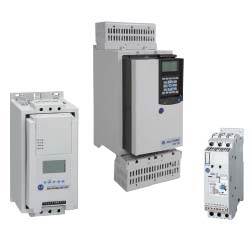Soft Starters: To Bypass or Not to Bypass? That is the Question
Soft starters are designed to limit current or soft start (ramp up the voltage) of a motor. The same holds true for braking or soft stopping. Simple settings perform the start and stop well. So what about in-between the start and the stop? Do you continue to use silicon-controlled rectifier (SCR) control or do you utilize a bypass contactor?
Some soft starters are fully solid-state - meaning no bypass is needed - and are IEC rated AC-53a for running on SCR control continuously on a squirrel-cage motor. Other soft starters are hybrids, which means that they are rated AC-53b intermittent duty and use a bypass when the motor is up to speed.
Here are some fully solid-state soft starter advantages:
- Can be used in a continuous run mode
- No mechanical wear and tear of components
- Excellent in high vibration applications
- Ability to handle non-traditional motor loads such as resistive and transformer loads
- Higher operations per hour compared to hybrid soft starters with integrated bypass, limiting factor being the bypass contactor itself
Applications that are well suited for a solid-state soft starter are:
- Rock crushers: the environment is dusty, dirty and has a lot vibration if the soft start is mounted close to the crusher
- De-barkers: similar to the rock crusher for the environment
- Hammer mills: places with a lot of vibration - where an electro-mechanical would have issues
- A solid state soft starter can handle the same applications as a hybrid soft starter
Did you notice a common theme? All of the applications involve harsh environments. Dirt and dust will not affect functionality because there are no mechanical parts to let dirt in and shorten the life of the unit. Some soft starters take this a step further and provide conformal coating, adding an extra level of protection against conductive dust or environmental corrosion.
The hybrid soft starters typically contain SCRs not rated for continuous duty because this controller is designed to utilize SCRs to start and stop, and no more. Use of a bypass contactor, either internal or external, allows an application to run continuously after the starting algorithm stops and the motor is at-speed. The bypass will open once a stop or fault command has been provided.
Here are some advantages of an internal bypass:
- Smaller form factor
- Less heat dissipation
- Simplified wiring
Here are some advantages of an external bypass:
- Fully rated contactor
- Less diagnostics preventing non-critical nuisance trips
- An application with frequent high current surges
The best applications for hybrid soft starters include:
- Fans
- Pumping
- Conveyors
- Less harsh environments
You need to know the motor application that will be controlled by the soft starter. After the start and stop method is selected, think about how the run mode in between is to operate. Then pick the appropriate run mode to fit the application. To assist with the thought process, ask the following about the application:
- Clean environment
- Vibration
- Space an issue
- Desire full diagnostics at full speed
- High duty cycle
Interested in learning more, contact us at any time.

